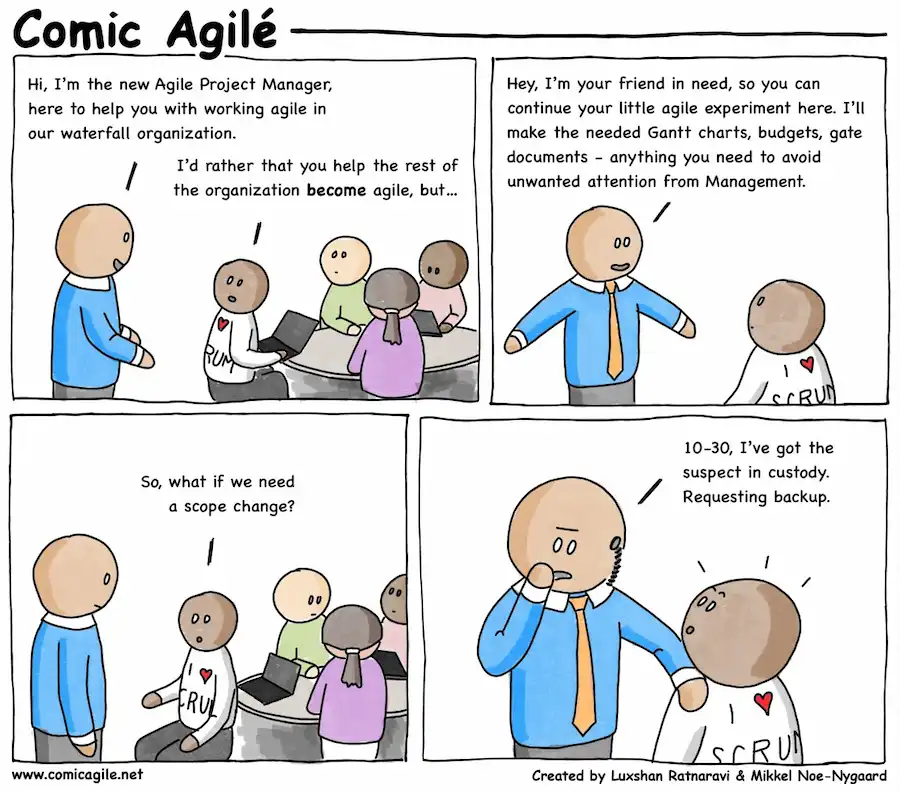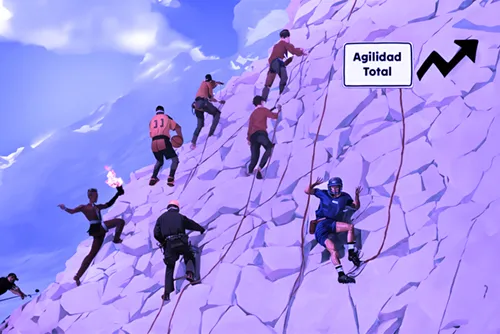¿Es posible escalar la agilidad sin perder su esencia?
En el ámbito de la transformación digital y la agilidad empresarial, surge un debate sobre la viabilidad de escalar la agilidad sin perder su esencia. Algunos abogan por la implantación de valores y principios ágiles en toda la organización como camino hacia la madurez, mientras que otros sostienen que solo puede lograrse en equipos pequeños. En este artículo, analizaremos este fascinante dilema y examinaremos diferentes perspectivas sobre este reto.
El espíritu del Manifiesto Ágil
Para entender mejor este debate, es crucial recordar el propósito original del Manifiesto Ágil. Este documento clave aboga por un enfoque centrado en las personas, la colaboración, la adaptabilidad y la entrega continua de valor.Sin embargo, al reinterpretar el espíritu del Manifiesto Ágil, debemos evitar las contradicciones que surgen al intentar aplicarlo de forma rígida y dogmática. Para ello, recordamos el siguiente valor del Manifiesto Ágil:
«Individuos e interacciones por encima de procesos y herramientas». – Manifiesto Ágil

La agilidad como mentalidad
En lugar de considerar la agilidad como un destino final, debemos entenderla como una mentalidad, una forma de pensar y trabajar que promueve la adaptabilidad y la resiliencia. Estableciendo una referencia de madurez apoyada por coaches ágiles, las organizaciones pueden establecer parámetros convencionales que desafíen y midan los comportamientos.Desde la filosofía y creencias de los agilistas, se enfatiza la relevancia de aplicar los principios ágiles a contextos reales, disponiendo de un marco de valores no negociables a la hora de aplicar dichos principios.
Es importante señalar que el objetivo no es replicar el éxito de empresas digitales de renombre, sino adoptar comportamientos que permitan a la organización adaptarse y prosperar en un entorno cambiante.
Aunque la agilidad sigue estando en el top of mind de muchas empresas, según el informe State of Agile Report 2022, el 89 % de las respuestas indican que los equipos ágiles de alto rendimiento tienen valores centrados en las personas, una cultura clara, herramientas y un liderazgo empoderado.
Esto significa que el éxito de la agilidad en su escenario de «éxito» beneficia no sólo a quienes la practican, sino a toda la organización.
La falacia de la agilidad total
Algunos enfoques promueven la ampliación de la agilidad a toda la empresa, con el objetivo de lograr una «agilidad empresarial» en la que los principios lean-agile estén presentes en todas las áreas. Sin embargo, esta expectativa puede crear ilusiones de que la agilidad es un proyecto paso a paso hacia una empresa totalmente ágil.
Por tanto, ¿es pertinente medir la madurez ágil? ¿Es posible alcanzar el último grado de madurez? Es esencial reconocer que ni Meta ni otras empresas digitales pueden afirmar que son 100% ágiles. En consecuencia, esforzarse por ser el líder absoluto en agilidad puede resultar en una garantía de nada.

Marcos ágiles a escala como sistema operativo
Cuando se habla de agilidad, es posible que aún oigamos referirse a ella como una metodología concreta. Los agilistas a menudo tienen que aclarar que esto es incorrecto y que, de hecho, existen abundantes metodologías, disciplinas y herramientas que permiten practicar la agilidad en una organización. Los autores de estos marcos se centran en conectar un ecosistema vivo de agilidad para que pueda ser adoptado, y a veces adaptado, por las empresas como factor de transformación.
Por lo tanto, se basan en una gran cantidad de conocimientos históricos disponibles en libros, artículos, estudios académicos, casos de uso y otras fuentes para desarrollar un marco conceptual que pretende tener un enfoque aplicado.
Este es el caso concreto de Scrum, al que también se denomina erróneamente método o metodología. Scrum es un marco que ayuda a equipos y organizaciones a generar valor a través de soluciones adaptativas para problemas complejos. Estos equipos también son conocidos como células ágiles, escuadrones, pods, crews, entre otros.
Entonces, ¿por qué hablamos de escalar un marco ágil? La visión es aún más ambiciosa. Se trata de extender los beneficios de los marcos a nivel de equipo (como Scrum), incorporando enfoques más lean y ágiles, para abarcar toda la empresa. Todala organización. Existen diferentes marcos escalados, como:
- Marco Ágil Escalado (SAFe)
- Scrum a gran escala (LeSS)
- Scrum@Scale (SaS)
- Ágil Disciplinado (DA)
- Marco Nexus
- Kanban para empresas
También se menciona el modelo «hazlo tú mismo, según tu contexto» de unFix, cuyo objetivo es diseñar organizaciones y estructuras organizativas utilizando una biblioteca de patrones para lograr adaptabilidad y flexibilidad.
Según César Machado, escalar la agilidad depende de los factores y el contexto de cada organización. No existe una fórmula única que funcione para todos. En lugar de centrarse en utilizar un marco ágil, es esencial facilitar y diseñar constantemente la forma de trabajar para cumplir los objetivos de la organización.
En la misma línea, Olina Glindevi subraya la importancia de definir el éxito propio de cada empresa a la hora de abordar el escalado de la agilidad. Esta definición puede no ser necesariamente comparable entre dos o más empresas.
La bimodalidad permite el cambio, ¿no?
Ignacio Sanz Espinosa propone la necesidad de articular una bimodalidad que permita el cambio organizativo y reconoce que un enfoque 100% ágil puede no ser viable. Así lo reafirma también el último informe State of Agile Report, en el que el 80% de los encuestados respondieron que operan combinando la agilidad con el enfoque en cascada (a veces criticado como «wagile»).
Y del mismo informe, una visión contraria es que a la pregunta de si el foco de la adopción de la agilidad en las empresas está en la mejora de procesos, eficiencias, o en una visión holística de la transformación digital para toda la empresa, el 61% de las respuestas se decantó por ambos enfoques. Sólo el 26% optó por un enfoque holístico, y el 13% por la mejora.
Esta es la razón del relativo éxito de los marcos escalados; buscan una convergencia de la modalidad operativa lean-agile que, combinada desde la mentalidad y las formas de operar, propone una nueva forma de trabajar que puede percibirse como bimodal, con el objetivo de posibilitar el cambio.
Elliot Wolf contrapone la idea de la empresa dual en la agilidad, en la que coexisten un modelo jerárquico y otro celular, ambos inclinados hacia la agilidad para impulsar la transformación deseada.Pero lo que nadie dice es que, según el propio John Kotter, esto sólo tiene éxito en el 0,001% de los casos. Especialmente en los otrora famosos «proyectos híbridos», en los que aún hoy se puede observar el papel del «director de proyecto ágil «.

Entonces, ¿cuáles son las referencias que debemos tener en cuenta para crecer saludablemente en agilidad en una organización más tradicional?
Adaptabilidad y resistencia como objetivos
El 49% de las empresas con prácticas ágiles consiguen incorporar la agilidad en todo el ciclo de vida de entrega de valor. En otras palabras, la adopción es un reto en sí misma. Entonces, ¿qué es lo que realmente se busca? En lugar de obsesionarse con la escala de la agilidad en sí misma, las organizaciones deberían centrarse en desarrollar su capacidad de adaptación y resistencia. Esto implica adoptar una mentalidad ágil a todos los niveles, promover la experimentación, el aprendizaje continuo y fomentar la autonomía y la colaboración entre los equipos.
La agilidad es un medio para alcanzar estos objetivos, no un fin en sí mismo.
La propia adaptabilidad (infinita) busca que el conjunto de metodologías y el aprendizaje continuo sean adoptados y practicados con disciplina para garantizar que aporten salud a la organización, para su crecimiento y enriquecimiento cultural.Este conocimiento es bastante dinámico, y el ejercicio requiere simplicidad, preparando a la organización no sólo para momentos de aprovechamiento de oportunidades, sino también para ser resiliente en tiempos de crisis.
La rendición de cuentas: el mayor reto a la hora de aumentar la agilidad
Escalar la agilidad implica conducir desde la visión, la estrategia y las carteras con principios lean y ágiles. Aquí es cuando entra en juego la gestión del flujo de valor , sincronizando diferentes equipos o incluso toda la organización, y siempre suena atractiva desde el punto de vista de la gestión empresarial, ya que permite aumentar la previsibilidad y la gobernanza de la empresa.
En el camino hacia la consecución de objetivos en este enfoque, no basta con sembrar la convicción inquebrantable de ser agilista o utilizar prácticas y herramientas de moda para intentar alcanzar la agilidad más allá de uno o dos equipos. Elliot Wolf subraya que es necesario construir una arquitectura de trabajo ágil hacia la «responsabilidad».
Cuando se habla de esta arquitectura de trabajo ágil, se hace referencia a tener diferentes componentes que «rindan cuentas» a la organización y, sobre todo, a entender si las diferentes prácticas ágiles generan efectivamente valor para el negocio y los clientes finales.
Marcio Sete argumenta que esta perspectiva se basa en la transparencia de la gobernanza, que implica tener visibilidad operativa y flujos de valor que permitan la autovalidación y la disponibilidad de criterios de decisión, objetivos y métricas, lo que permite obtener la responsabilidad necesaria para generar transformaciones en la forma de operar, integrando los principios lean-agile.
Sobre el reto evolutivo
Melissa Beckmann presenta el reto evolutivo de escalar la agilidad, reconociendo la complejidad de las cuestiones humanas y la necesidad de abordar aspectos como las emociones, las relaciones y la satisfacción en los procesos de adaptación, lo que nos lleva a preguntarnos si la agilidad, con su ritmo acelerado, puede estar dejando de lado aspectos relevantes en la evolución organizativa.

Cuando se adopta la mentalidad y dichos principios, ¿hasta qué punto puede ser disruptivo?
Respetar y cambiar la cultura al mismo tiempo es dar prioridad a las personas. – Melissa Beckmann
También implica ser coherente con la mentalidad ágil. También implica responsabilizarse de la deuda humana.
Reflexiones finales
El dilema de escalar la agilidad sin perder su esencia plantea cuestiones interesantes en el ámbito de la transformación digital y la agilidad empresarial.
Al reinterpretar el espíritu del Manifiesto Ágil y adoptar una mentalidad ágil, las organizaciones pueden desarrollar su capacidad de adaptación y resistencia.Ampliar la agilidad no implica buscar la agilidad total, sino centrarse en alcanzar objetivos de adaptabilidad y resistencia.
Cada empresa debe definir su propio camino para escalar la agilidad, teniendo en cuenta su contexto y sus características particulares. Al hacerlo, podrán afrontar retos y aprovechar oportunidades en su camino hacia la excelencia empresarial en la era digital.Nunca olvides que en el centro de la transformación están las personas, y en el proceso de cambio, debemos ser coherentes con el mensaje.
💡Contribuidores:
- Olina Glindevi – Agile Coach y Directora de The Visual Agile Coach
- Ignacio Sanz Espinosa – Director de Operaciones de Evolve Up
- Melissa Beckmann – Consultora y Coach en Evolve Up
- César Machado – Formador Scrum & Scrum@Scale
- Marcio Sete – CPO y CEO de Flomatika
- Elliot Wolf Caddeo – CEO y Cofundador SKALLING / SAFe SPC
- Rod Bermúdez – Cofundador SKALLING
✨Diseñado por:
- Harold Chacón – DesignOps Lead SKALLING
Fuentes de colaboración




